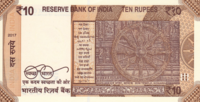TheIndian 10-rupee banknote(₹10) is a common denomination of theIndian rupee.The₹10 note was one of the first notes introduced by theReserve Bank of Indiaas a part of theMahatma Gandhi Seriesin 1996. These notes are presently in circulation along with theMahatma Gandhi New Serieswhich were introduced in January 2018, this is used alongside the10 rupee coin.
| (India) | |
|---|---|
| Value | ₹10 (approx. $0.13) |
| Width | 123 mm |
| Height | 63 mm |
| Security features | Security thread, micro-lettering, watermark, numerals growing from small to big and a see through registration device.[1] |
| Years of printing | January 2018 – present |
| Obverse | |
 | |
| Design | Mahatma Gandhi |
| Designer | Reserve Bank of India |
| Design date | 2017 |
| Reverse | |
 | |
| Design | Konark Sun Temple |
| Designer | Reserve Bank of India |
| Design date | 2017 |
The 10-rupee banknote has been issued and had been in circulation since colonial times, and in continuous production since Reserve Bank of India took over the functions of the controller of currency in India in 1923.[2]
Mahatma Gandhi New Series
editOn 5 January 2018, the Reserve Bank of India announced, a new redesigned₹10 banknote.[3]
Design
editThe Reserve Bank of India issued₹10 denomination banknotes in the Mahatma Gandhi (New) Series with motif of Sun Temple, Konark on the reverse, depicting the country's cultural heritage. The base colour of the note isChocolate brown.Dimensions of the banknote are 123 mm × 63 mm.
Security features
editThe security features seen on the new Mahatma Gandhi series 10 rupee note are:
- See through register with denominational numeral 10
- Denominational numeral १० inDevnagari
- Micro letters "RBI","भारत "," INDIA "and" 10 "
- Windowed demetalised security thread with inscriptions "भारत" and "RBI"
- Mahatma Gandhiportrait and electrotype 10Watermark
- Number panel with numerals growing from small to big on the top left side and bottom right side]
- Year of printing of the note on the back
History
edit-
Indian ten rupee old note
George VI Series
editThe 10 rupee banknote of the George VI Series in 1937, had the portrait ofGeorge VIon the obverse and featured two elephants with the banknote denomination written inUrdu,Hindi,Bengali,Burmese,Telugu,Tamil,KannadaandGujaration the reverse.[4]
The 10 rupee banknote of theLion Capital Seriesin 1970, had theAshoka pillarand the banknote denomination written inHindi,Assamese,Bengali,Gujarati,Kannada,Kashmiri,Malayalam,Marathi,Odia,Punjabi,Sanskrit,Tamil,TeluguandUrduon the obverse, and featured twopeacocksand the banknote denomination written in English on the reverse.[5]
Mahatma Gandhi Series
editDesign
editThe₹10 banknote of theMahatma Gandhi Seriesis 137 × 63 mm Orange-violet coloured, with the obverse side featuring a portrait ofMahatma Gandhiwith a signature of the governor ofReserve Bank of India.It does not have theBraillefeature that assists the visually challenged in identifying the currency. The reverse side features a motif of aRhinoceros,anelephantand atiger,all together asFauna of India.
As of 2011, the new₹signhas been incorporated into banknote of₹10.[6]In January 2014 RBI announced that it would be withdrawing from circulation all banknotes printed prior to 2005 by 31 March 2014. The deadline was later extended to 1 January 2015, then further to 30 June 2016.[7]
As per an announcement made by theReserve Bank of India(RBI) in March 2017, a new version of the Indian 10 Rupee note will be issued soon, with better security features. The year of printing will be on the reverse note side. The numerals printed inside both note panels will be in ascending size, from left side to right side.[8]
Security features
editThe security features of the₹10 banknote includes:[9]
- A windowedsecurity threadthat reads 'भारत' (Bharata in theDevanagariscript) and 'RBI' alternately.
- WatermarkofMahatma Gandhithat is a mirror image of the main portrait.
- The number panel of the banknote is printed in embeddedfluorescentfibers and optically variable ink.
- Since 2005 additional security features like machine-readable security thread, electrotype watermark, and year of print appears on the bank note.
Languages
editAs like the otherIndian rupeebanknotes, the₹10 banknote has its amount written in 17 languages. On the obverse, the denomination is written inEnglishandHindi.On the reverse is a language panel which displays the denomination of the note in 15 of the 22official languages of India.The languages are displayed in alphabetical order. Languages included on the panel areAssamese,Bengali,Gujarati,Kannada,Kashmiri,Konkani,Malayalam,Marathi,Nepali,Odia,Punjabi,Sanskrit,Tamil,TeluguandUrdu.
| Denominations incentral level official languages(At below either ends) | |||||||||||
|---|---|---|---|---|---|---|---|---|---|---|---|
| Language | ₹10 | ||||||||||
| English | Ten rupees | ||||||||||
| Hindi | दस रुपये | ||||||||||
| Denominations in 15state level/other official languages(As seen on the language panel) | |||||||||||
| Assamese | দহ টকা | ||||||||||
| Bengali | দশ টাকা | ||||||||||
| Gujarati | દસ રૂપિયા | ||||||||||
| Kannada | ಹತ್ತು ರೂಪಾಯಿಗಳು | ||||||||||
| Kashmiri | دٔہ رۄپیہِ | ||||||||||
| Konkani | धा रुपया | ||||||||||
| Malayalam | പത്തു രൂപ | ||||||||||
| Marathi | दहा रुपये | ||||||||||
| Nepali | दस रुपियाँ | ||||||||||
| Odia | ଦଶ ଟଙ୍କା | ||||||||||
| Punjabi | ਦਸ ਰੁਪਏ | ||||||||||
| Sanskrit | दश रूप्यकाणि | ||||||||||
| Tamil | பத்து ரூபாய் | ||||||||||
| Telugu | పది రూపాయలు | ||||||||||
| Urdu | دس روپیے | ||||||||||
References
edit- ^"Are there any special features in the banknotes of Mahatma Gandhi series- 1996?".Your Guide to Money Matters.Reserve Bank of India. Archived fromthe originalon 12 January 2012.Retrieved11 January2012.
- ^"India Paper Money A Retrospect".Republic India Issues.Reserve Bank of India. Archived fromthe originalon 18 January 2012.Retrieved16 January2012.
- ^"Reserve Bank of India - Press Releases".
- ^10 rupee banknote - 1937 - image - banknote.ws
- ^10 rupee banknote - 1970 - image - banknote.ws
- ^"Issue of ₹10/- Banknotes with incorporation of Rupee symbol (₹)".RBI.Retrieved23 September2011.
- ^"Withdrawal of Currencies Issued Prior to 2005".Press Information Bureau. 25 July 2014.Retrieved25 July2014.
- ^"New Rs 10 notes with more security coming soon".The Times of India.9 March 2017.
- ^RBI -₹10 security features